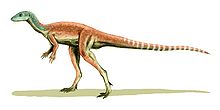- Eocursor
-
Eocursor
Temporal range: Late Triassic, 210 Ma
Restoration Scientific classification 
Kingdom: Animalia Phylum: Chordata Class: Reptilia Superorder: Dinosauria Order: †Ornithischia Genus: †Eocursor
Butler, Smith & Norman, 2007Species: †E. parvus Binomial name Eocursor parvus
Butler, Smith & Norman, 2007Eocursor (meaning "dawn runner") was a primitive genus of dinosaur which lived during the Late Triassic (Norian age), around 210 million years ago. It was an ornithischian which lived in what is now South Africa. Remains of this animal have been found in the Lower Elliot Formation and are the most complete known from a Triassic ornithischian, shedding new light on the origin of this group.[1]
Fossils of Eocursor were originally collected in 1993, but were not formally described until fourteen years later. The type species, Eocursor parvus, was described in 2007 by Richard J. Butler, Roger M. H. Smith, and David B. Norman. Eocursor was one of the earliest known ornithischians, and sheds some light on early dinosaur relationships because early dinosaurs are known from mostly incomplete skeletons. Eocursor is known from partial skeletal elements, including skull fragments, spinal elements, pelvis, long leg bones, and unusually large grasping hands.
Contents
Description
Eocursor was a lightly built bipedal dinosaur with an estimated length of about 1 m (3 ft). The general aspect of the animal resembles the one of the early Jurassic ornithischians such as Lesothosaurus and Scutellosaurus. Its large hands resembled those of the Heterodontosauridae, a clade of primitive ornithischians. The morphology of the triangular teeth, not unlike those of an iguana, suggests partial herbivory. The tibia was significantly longer than the femur, indicating Eocursor was a swift runner. [1]
Discovery and naming
In 1993, the holotype specimen of Eocursor (SAM-PK-K8025) was collected from the Lower Elliot Formation in Free State, South Africa. The skeleton, although only partially complete, is one of the best-preserved early ornithischian skeletons ever found. The fossils include a partial skeleton: portions of the skull, lower jaw, vertebrae, and limbs.[1]
In June 2007, the fossils were formally described by an international team of paleontologists: Richard Butler of the Natural History Museum, London, and the University of Cambridge, David Norman of the University of Cambridge, and Roger M. H. Smith of the Iziko South African Museum. The fossils were named Eocursor parvus, from the Greek word eos (meaning "dawn"), and the Latin words cursor (meaning "runner") and parvus ("little"), "in reference to the early occurrence of this ornithischian, its apparent locomotory abilities and its small size."[1]
Classification
Eocursor was an early ornithischian, one of the first so-called "bird-hipped" dinosaurs, a group which would eventually give rise to animals such as Stegosaurus, Triceratops, and Iguanodon. Butler et al. consider Eocursor more primitive than Lesothosaurus, but more derived than the Heterodontosauridae and Pisanosaurus, as a basal ornithischian forming a sister clade of Genasauria.[1]
References
- ^ a b c d e Butler, Richard J.; Roger M. H. Smith and David B. Norman (2007). "A primitive ornithischian dinosaur from the Late Triassic of South Africa, and the early evolution and diversification of Ornithischia". Proceedings of the Royal Society B: Biological Sciences 274 (1621): 2041. doi:10.1098/rspb.2007.0367. PMC 2275175. PMID 17567562. http://www.pubmedcentral.nih.gov/articlerender.fcgi?tool=pmcentrez&artid=2275175.
External links
Categories:- Dinosaurs of Africa
- Fossil taxa described in 2007
- Ornithischians
- Triassic dinosaurs
Wikimedia Foundation. 2010.
